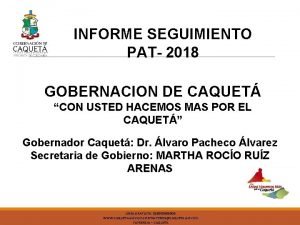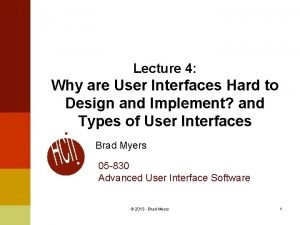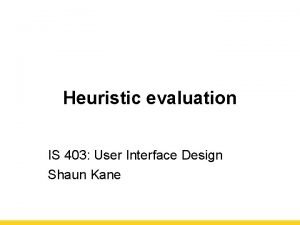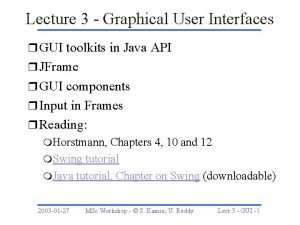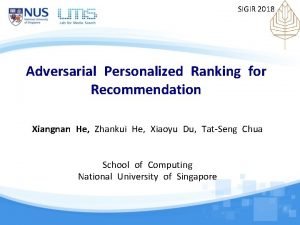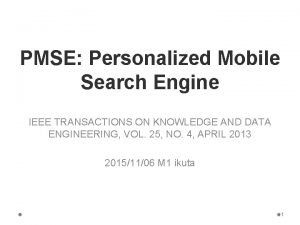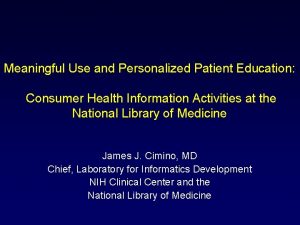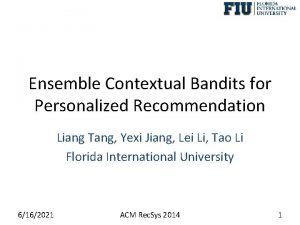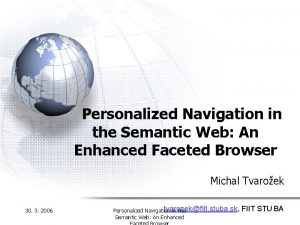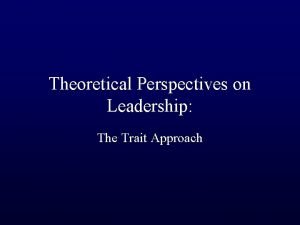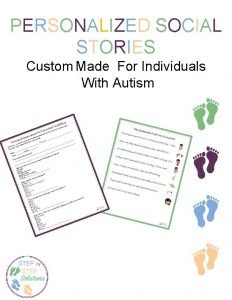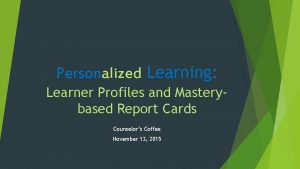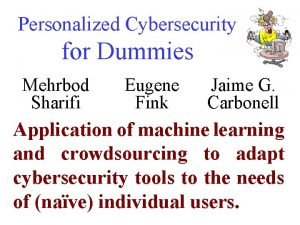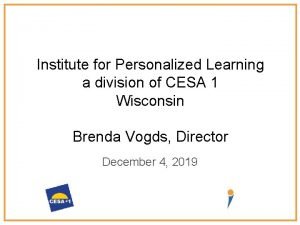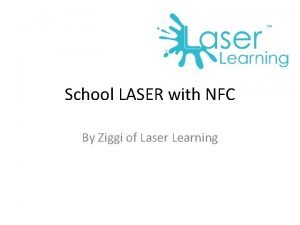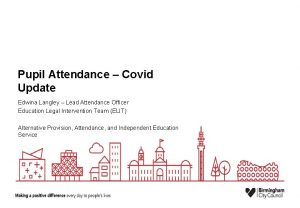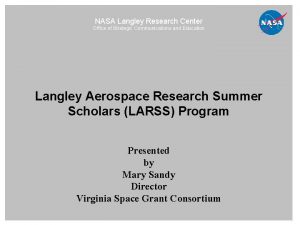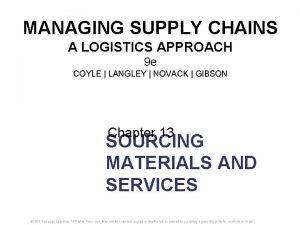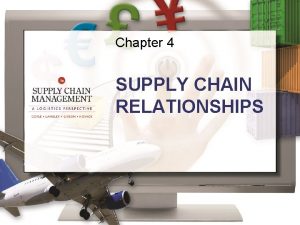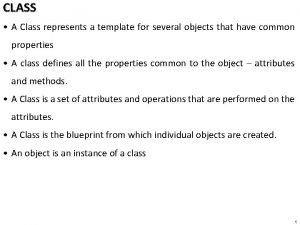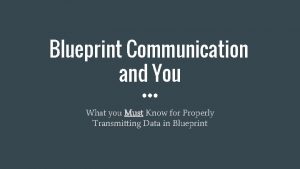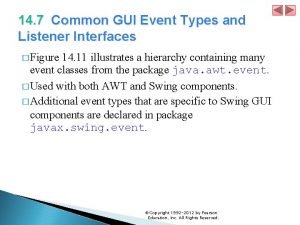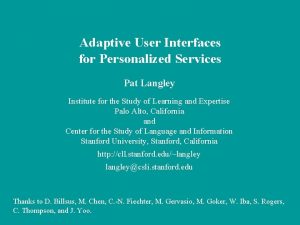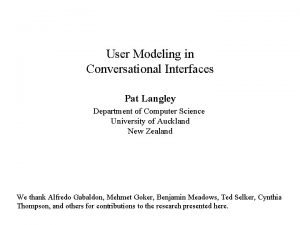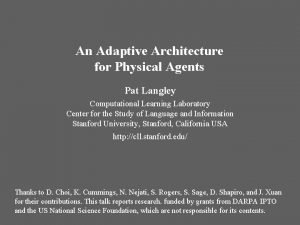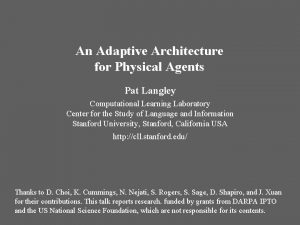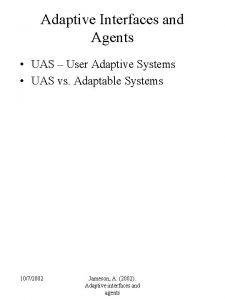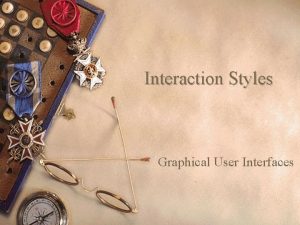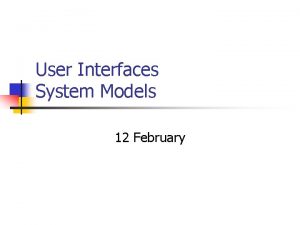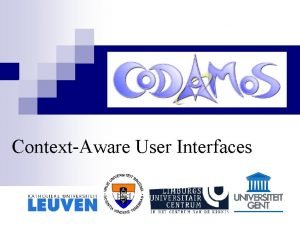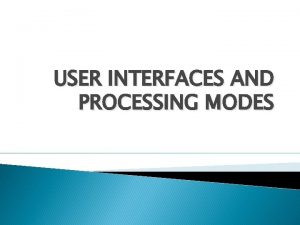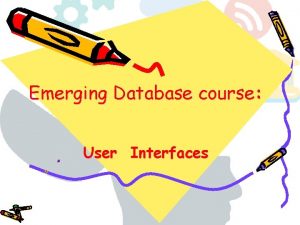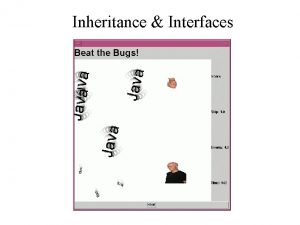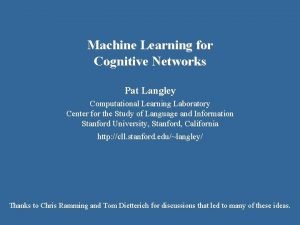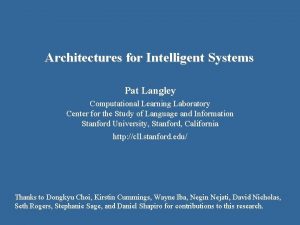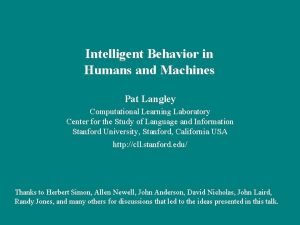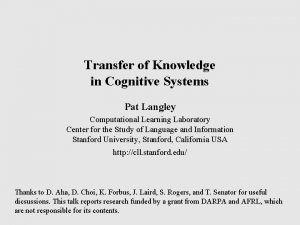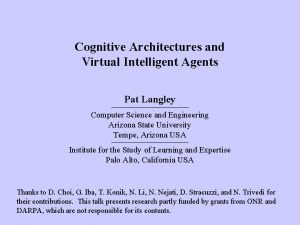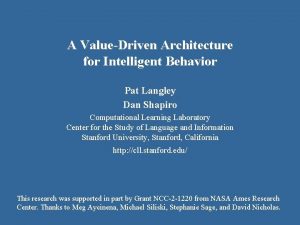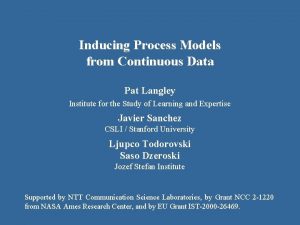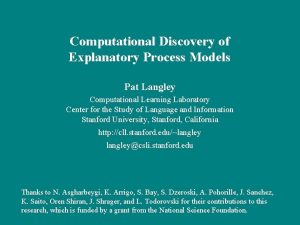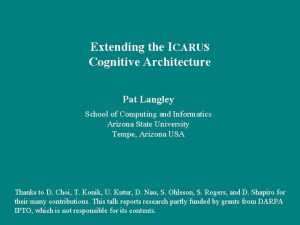Adaptive User Interfaces for Personalized Services Pat Langley













































- Slides: 45

Adaptive User Interfaces for Personalized Services Pat Langley Institute for the Study of Learning and Expertise Palo Alto, California and Center for the Study of Language and Information Stanford University, Stanford, California http: //www. isle. org/~langley@csli. stanford. edu

The Need for Intelligent Assistance As information and choices become more available, users need help in finding, and selecting among, the many alternatives. This has led to the development of recommendation systems, which attempt to locate and recommend relevant items.

The Need for Personalized Assistance At the same time, society is becoming ever more diversified. Differences in private and professional preferences are growing. Internet users are becoming increasingly selective about what they want to see and purchase. We need personalized systems that can give users the information or product they want. But personalized response requires some model or profile of the user.

Approaches to User Modeling There are four distinct approaches to creating and utilizing user profiles for personalized services: • manual creation by individual users (e. g. , My. Yahoo); • manual creation of stereotypes and assignment of users based on demographic or behavioral data; • offline learning of stereotypes from demographic/behavioral data and assigning users to them; • online learning of individual user models from traces of their interactions. We will refer to systems of the last sort as adaptive user interfaces.

The Problem of Learning Individual Models We can state the problem confronting adaptive user interfaces as: • • Given: a set of tasks that require some user decision Given: descriptions for each of these tasks Given: traces of the user’s decision on each task Find: mappings from task features to user decisions There exist two broad approaches to describing the user’s task: • collaborative methods refer to other users’ responses to the task • content-based methods refer to measurable features of the task Our work focuses on content-based approaches to user modeling.

Examples of Adaptive User Interfaces Adaptive interfaces have been developed for many different tasks: • • • Command form completion Email filtering and filing News selection and layout Browsing the World Wide Web Selecting movies and TV shows On-line shopping In-car navigation Interactive scheduling Dialogue systems These efforts cover a wide spectrum but also raise common issues.

Definition of an Adaptive User Interface a software artifact by acquiring a user model that reduces user effort based on past user interaction

Definition of a Machine Learning System a software artifact by acquiring knowledge that improves task performance based on partial task experience

Steps in Developing an Adaptive Interface Formulating the Problem Engineering the Representation Collecting User Traces Modeling Process Utilizing Model Effectively Gaining User Acceptance

The Task of Route Selection A decision-making task that confronts drivers can be stated as: • Given: The driver’s current location C; • Given: The destination D that the driver desires; • Given: Knowledge about available roads (e. g. , a digital map); • Find: One or more desirable routes from C to D. Computational route advisors already exist in both rental cars and on the World Wide Web. However, they do not give personalized navigation advice to individual drivers.

An Approach to Route Selection Here is a one approach to learning route preferences, though not the first we considered: • Formulation: Learn a “subjective” function to evaluate entire routes • Representation: Global route features computable from digital maps • Data collection: Preference of one complete route over another • Induction: A method for learning weights from preference data • Utilizing model: Apply subjective function to find “optimal” route This method learns a user model with respect to the entire route. In this way, it avoids two important problems: data fragmentation and credit assignment.

The Adaptive Route Advisor We have implemented this approach in the Adaptive Route Advisor (Fiechter, Rogers, & Langley, 1999), which: • models driver preferences in terms of 14 global route features • gives the driver two alternative routes he might take • lets the driver refine these choices along route dimensions • uses driver choices to refine its model of his preferences • invokes the driver model to recommend future routes Note that providing drivers with choices lets the system collect data on route preferences in an unobtrusive manner.

The Adaptive Route Advisor

Driver Model and Training Cases The Adaptive Route Advisor represents the driver model as a weighted linear combination of route features. Time Distance Intersections Turns w 0 w 1 w 2 w 3 Cost Training data: [x 0, x 1, x 2, x 3] is better than [y 0, y 1, y 2, y 3]. The system uses each training pair as constraints on the weights found during the learning process.

Experimental Results on Route Advice Experiments with 24 subjects show the Route Advisor improves its predictive ability rapidly with experience.

Experimental Results on Route Advice Analyses also show that personalized user models produce better results than generalized models, even when given more data.

The Task of Destination Selection Aother type of decision that confronts drivers can be stated as: • Given: The driver’s current location C; • Given: Some goal the driver wants to achieve (e. g. , eat lunch); • Given: Knowledge about available nearby destinations; • Find: One or more destinations D that achieve the goal. Many recommendation systems are available on the World Wide Web, including ones that suggest restaurants. However, they are ill suited for use in the driving environment, where visual attention is a limited resource.

Conversational Destination Advice One approach to destination recommendation can be cast as: • • • Formulation: Learn to predict features user cares about in items Representation: Conditions/weights on attributes and values Data collection: Converse with user to help him make decisions, noting whether he accepts or rejects questions and items Induction: Any supervised induction method Utilizing model: Guide the dialogue by selecting informative questions and suggesting likely values This formulation relies on the notion of a conversational user interface. Spoken-language versions of this approach appear well suited to the driving environment.

The Adaptive Place Advisor We implemented this approach in the Adaptive Place Advisor (Langley, Thompson, Elio, & Haddadi, 1999), which: • carries out spoken conversations to help user refine his goals • incorporates a dialogue model to constrain this process • collects and stores traces of interaction with the user • personalizes both its questions and recommended items Our work to date has focused on recommending restaurants to users who want advice about where to eat. We believe this approach to recommendation will work well for drivers, but it also has broader applications.

A Sample Destination Dialogue Inquirer: Where do you think I should eat tonight? Advisor: Well, what type of cuisine would you like? Inquirer: What types are there? Advisor: Some examples are Chinese, Indian, and Mediterranean. Inquirer: Oh, maybe Indian. Advisor: What quality rating would you like? Inquirer: I don't care, as long as it's cheap. Advisor: How do you want to pay? Inquirer: No, I think I'd like Chinese instead. Advisor: Okay, we'll switch to Chinese food. What city do you prefer? Inquirer: How about Berkeley? Advisor: I know three cheap Chinese restaurants in Berkeley. One is the Long Life Vegi House on 2129 University Avenue. Does that sound alright? Inquirer: Sure, that sounds fine.

Speech Acts Per Conversation with Place Advisor

Time Per Conversation with Place Advisor

The Task of Resource Scheduling Another complex problem that people encounter can be stated: • Given: A set of tasks or jobs that must be done soon; • Given: A limited set of resources available for these jobs; • Given: Knowledge about constraints on jobs and resources; • Find: One or more schedules that complete the jobs. Many automated scheduling systems are used in industry, and some interactive schedulers exist. But these systems do not generate personalized schedules that reflect the preferences of individual users.

An Approach to Personalized Scheduling Here is one approach to preferences about learning schedules: • Formulation: Learn a utility function to evaluate entire schedules • Representation: Global features computable from the schedule • Data collection: Preference of one complete schedule over another • Induction: A method for learning weights from preference data • Utilizing model: Apply subjective function to find a good schedule This method is similar to that used in the Adaptive Route Advisor. However, it assumes search through a space of complete schedules (a repair space), which needs a way to generate an initial schedule.

The INCA System We have developed INCA (Gervasio, Iba, & Langley, 1999), an interactive scheduler that: • retrieves an initial schedule from a personalized case library • suggests to the user improved schedules from which to select • lets the user direct search to improve on certain dimensions • collects user choices to refine its personalized utility function • stores solutions in the case base to initialize future schedules • invokes the user model to recommend future schedule repairs As before, providing users with choices lets the system collect data on schedule preferences in an unobtrusive manner.

Experimental Results with INCA Experiments with the INCA scheduling system suggest that: • it improves its ability to predict user choices over time • personalized case libraries are more effective than generic • its advice provides greater benefit on harder problems • linear models give useful predictions even when false • more detailed guidance speeds the user-modeling process These studies (Gervasio et al. , 1999) used a mixture of human and synthetic subjects.

INCA and Task Characteristics Experiments with INCA suggest that retrieving personalized schedules helps users more as task difficulty increases.

Personalized Bookmarks

Personalized Music Delivery

Challenges of Adaptive Interfaces Adaptive user interfaces have clear attractions but also pose some challenges to developers: • formulation of user modeling as an induction task • engineering of representation to support learning process • unobtrusive collection of training data from users • effective application of learned user model • requirement for some form of online learning • necessity for induction from few training cases These challenges overlap with other applications of machine learning, but also raise some new issues.

The Promise of New Sensors Adaptive interfaces rely on user traces to drive their modeling process, so they stand to benefit from developments like: • GPS and cell phone locators • robust software for speech recognition • accurate eye and head trackers • real-time video systems • wearable body sensors (GSR, heart rate) • portable brain-wave sensors As such devices become cheap and widespread, they will give us new sources of data and support new types of adaptive services.

Concluding Remarks In summary, adaptive interfaces integrate ideas from machine learning, intelligent agents, and human-computer interaction. This approach to automated personalization of online services: • has many examples already in regular and successful use, • but many unexplored niches for research and application, • and challenges involving integration rather than new methods. These adaptive systems promise to change the way we interact with, and think about, computer software.


Behavior Traces An important source of data comes from traces of user activity. Examples of such trace data include: • • records of keystrokes and mouse clicks click streams from Web browsers outcomes of electronic purchases user responses to presented options Collection of user traces can occur during the normal course of interacting with a system or service. Thus, this approach is less obtrusive than either questionairres or rating forms.

Elements of an Adaptive Interface user interface human user model adaptive algorithm

Elements of Machine Learning performance element environment knowledge learning algorithm

Five Paradigms for Machine Learning Rule Induction Decision-Tree Induction Neural Networks Case-Based Learning Probabilistic Learning

Problem Formulation The first hurdle of an adaptive interface developer can be stated: • Given: Some task that an intelligent assistant could aid; • Find: Some formulation that lets the assistant improve its performance by learning a user model from experience. This decision includes making clear design choices about: • the aspect of user behavior to be predicted; • the level of description (what constitutes a training case). Since most robust learning methods focus on supervised learning, most adaptive interfaces formulate the task in these terms.

Representation Engineering Another stage in developing an adaptive interface can be stated: • Given: A formulation of some task in machine learning terms; • Find: Some representation for behavior and user models that makes the learning task tractable. This decision includes making clear design choices about: • the information to be used when predicting behavior; • the internal encoding of that information in the system. Since most robust learning methods assume an attribute-value formalism, most adaptive interfaces take this approach.

Collecting User Traces A third step in designing an adaptive interface can be posed as: • Given: A problem formulation in terms of machine learning and a representation of user behavior; • Find: An effective way to collect traces of this behavior. This decision includes making clear design choices about: • how to transform these traces into training instances; • what action the user must take to generate the traces. Since people seldom like extra burdens, an ideal adaptive interface requires no extra user effort to collect such traces.

Using the Learned Model Another essential step in the development process can be stated: • Given: An approach to learning a user model for some task; • Find: Some way to invoke the model that helps the user perform the task more effectively. This decision includes making clear design choices about: • when and how to present the model’s predictions to user; • how to handle cases in which these predictions are wrong. The ideal adaptive interface lets the user take advantage of good predictions and ignore bad ones.

Gaining User Acceptance A final important facet of the development process can be stated: • Given: A complete adaptive user interface for some task; • Find: Ways to get people to try the system and to become long -term users. Attracting first-time users involves marketing much more than technology, but, without it, a good system may be ignored. However, a system that is well-designed and easy to use is more likely to retain users over long periods.

Updating the User Model INCA represents its user model as a weighted linear combination of schedule features (three for the Haz. Mat domain). Spilled Burned Health Risk w 1 w 2 w 3 Utility Training case: Sched[x 1, x 2, x 3] is better than Sched[y 1, y 2, y 3]. The system determines weights from such data in the same way as does the Adaptive Route Advisor.

Setting for an Adaptive Interface Task / Content / Profiles Adaptive Interface User / Customer

Adaptive Interfaces as Psychological Models One can view adaptive interfaces as automatically creating cognitive simulations, in that they: • develop knowledge structures to describe user preferences • make explicit predictions about the user’s future behavior • explain individual differences through personalization But we can distinguish two approaches to cognitive simulation: • process models that embody architectural principles • content models that describe behavior at the knowledge level Both should play a role in HCI, but content models seem more relevant for the adaptive aspects of user interfaces.
 Pat pat seguimiento
Pat pat seguimiento Web user interface
Web user interface Why are user interfaces hard to implement
Why are user interfaces hard to implement Gulf of execution and evaluation
Gulf of execution and evaluation Gui for r
Gui for r User interfaces design dc
User interfaces design dc Pat-r scale score chart
Pat-r scale score chart Hexiangnan
Hexiangnan Personalised mobile search engine
Personalised mobile search engine Zaponet
Zaponet Personalized patient education
Personalized patient education Contextual bandits for personalized recommendation
Contextual bandits for personalized recommendation Dietmar jannach
Dietmar jannach Personalized navigation
Personalized navigation Personal statement first draft
Personal statement first draft Communication operations
Communication operations Limitations of trait theory of leadership
Limitations of trait theory of leadership Social stories questionnaire
Social stories questionnaire Personalized learning learner profile
Personalized learning learner profile Clara natoli
Clara natoli Personalized cybersecurity
Personalized cybersecurity Institute for personalized learning
Institute for personalized learning Single user and multiple user operating system
Single user and multiple user operating system Multi user operating system
Multi user operating system Lhpa laser login
Lhpa laser login Cardinal langley rc high school
Cardinal langley rc high school Cardinal langley holiday club
Cardinal langley holiday club Biography rosie langley wikipedia
Biography rosie langley wikipedia Edwina langley birmingham
Edwina langley birmingham Edwina langley birmingham
Edwina langley birmingham Edwina langley birmingham
Edwina langley birmingham Al langley nasa
Al langley nasa Nasa langley org chart
Nasa langley org chart Hayley langley
Hayley langley Item procurement importance matrix
Item procurement importance matrix C. john langley, jr., ph.d.
C. john langley, jr., ph.d. Short term rentals langley
Short term rentals langley Expressive interfaces
Expressive interfaces Uml interfaces are used to:
Uml interfaces are used to: Office interface vs industrial interface
Office interface vs industrial interface Difference between abstract classes and interfaces
Difference between abstract classes and interfaces Difference between abstract classes and interfaces
Difference between abstract classes and interfaces What are expressive interfaces?
What are expressive interfaces? Designing interfaces and dialogues
Designing interfaces and dialogues Blueprint interfaces
Blueprint interfaces Common gui event types and listener interfaces in java
Common gui event types and listener interfaces in java
